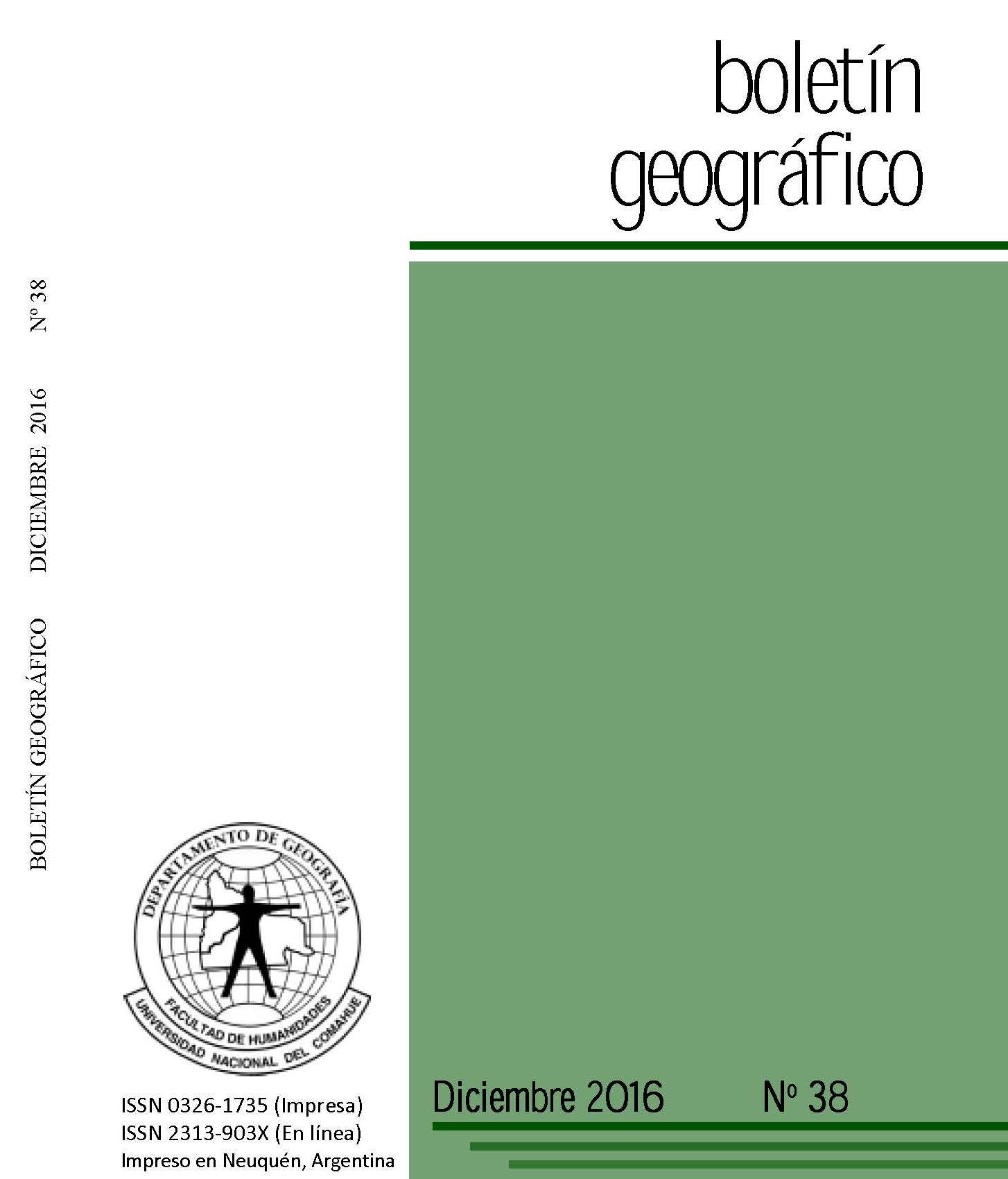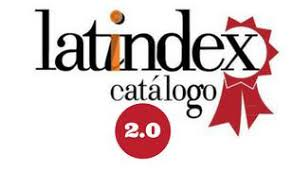Geomorphological study of chamical region (la rioja, argentina) as the basis for the analysis of natural hazards
Keywords:
geomorphological map, satellite images, morphoestructural units, morphoestructural processesAbstract
Chamical region is located in a semiarid morphoclimatic area. Its characteristic morphodynamic processes are fluvial and eolian. On the other hand the topographical and seismotectonic characteristics of the region lead to azonal modelers agents, such as gravity and seismic events, which do not depend on climate conditions. These processes are active currently in a state of constant evolution. The
goal of this work is to develop a geomorphological map of the Chamical region.The morphoestructural units grouping different landforms, as well as the morphodynamic processes that gave rise to them, were demarcated. This map is an initial basic tool for risk assesment. Information was taken from geological maps 1: 250000 published by Geological and Mining Service of Argentina (SEGEMAR),
SPOT images obtained from Google Earth and the 250 GIS data base of the National Geographic Institute (IGN). Morphostructural units grouping different landforms and morphogenetic processes were defined according to Demek criteria (1976).
From the development of the geomorphological map of Chamical it was determined that the geomorphology of the area shows an important component of the endogenous tectonic morphogenetic process that resulted in the generation of mountain and valley systems. Currently, fluvial-wind processes shape a mountain landscape with fluvial valleys structurally controlled. To identify these processes, the use of images of Google Earth was very useful due to their high spatial resolution (SPOT multispectral images up to 2.5 meters) .Although the use of images has allowed to develop this work, the importance of validating the information through field work is recognized.
Downloads
References
ABRAHAM, E. (2000). Geomorfología de la provincia de Mendoza. En Abraham, E. y Rodríguez Martínez, F. (Eds.) Publicación en Argentina de los resultados del Programa de Cooperación para la Investigación. Junta de Gobierno de Andalucía, España y Universidades y Centros de Investigación de la Región Andina Argentina. Mendoza, Fundación CRICYT / CONICET. Recuperado de http://www.cricyt.edu.ar/ladyot/catalogo/cdandes/cap04.htm
ANDRADE, M. (2005). Inundaciones en la provincia de Buenos Aires. Factores naturales y antrópicos desde una teoría social del riesgo. La cuenca Parano-Platense. Período 1980-2000. En Simposio Problemáticas Ambientales. Séptimo Encuentro Internacional Humboldt. Villa de Merlo, Argentina, 8 pp.
BERTRAND, G. (1978). Le paysage, entre la nature et la societé. Revue Géographique des Pyrénnées et du Sud-Ouest, 49-2, 239-258.
BILKRA L.H. y NEMEC, W. (1998). Postglacial colluvium in western Norway: depositional process, facies and paleoclimatic record. Sedimentology, 45, 909-959. Colegio de Ingenieros del Perú (1998). Informe del fenómeno El Niño 1997-1998. Lima, Consejo Nacional, 110 pp.
CASA A., YAMIN M., CEGARRA M., COPPOLECCHIA M. y COSTA C. (2010). Deformación cuaternaria asociada al frente de levantamiento oriental de Las Sierras de Velasco y Ambato, Sierras Pampeanas Occidentales. Revista de la Asociación Geológica Argentina, 67 (4), 425 – 438.
DEMEK, J. (1976). Geomorphological Mapping 1972-1976. Proceedings of the 11th Meeting IGU Commission of Geomorphological Survey and Mapping 23rd International Geographical Congress, Kiev. Studia Geographica, 55 pp.
ERHART, E. (1967). La génese des sols en tant que phenoméne géologique. Esquisse d’une teorie géologique et géochimique. Paris, Editorial Masson.
GARCÍA RUÍZ, J.M., WHITE, S., MARTÍ-BONO, C., VALERO, B., ERREA, M.P. y GÓMEZ VILLAR, A. (2004). La avenida del barranco de Arás y los riesgos hidrogeológicos en el pirineo central español. En: Peña, J.L.; Longarres, L.A. & Sánchez, M. (Eds.) (pp. 131-140). Geografía Física de Aragón. Aspectos generales y temáticos. Zaragoza, Universidad de Zaragoza e Institución Fernando el Católico.
FERNÁNDEZ CASO, M.; BERTONCELLO, R.; BLANCO, J.; CICCOLELA, P. y NATENZON, C. (2007). Geografías y territorios en transformación. Nuevos temas para pensar la enseñanza. INDE – NovEduc Coeditores. Buenos Aires, Argentina, 112 pp.
GONZÁLEZ, S.; BARRENECHEA, J.; GENTILE, E y NATENZON, C. (1998). Riesgos en Buenos Aires. Caracterización preliminar. PIRNA-Programa de Investigaciones en Recursos Naturales y Ambiente, Instituto de Geografía, FFyL.,
UBA. En Seminario de Investigación Urbana El Nuevo Milenio y lo Urbano. Buenos Aires, 52 pp.
GONZÁLEZ BONORINO, F. (1950). Algunos problemas geológicos de las Sierras Pampeanas. Revista de la Asociación Geológica Argentina, 5 (3), 81-110.
GUSTAVSSON, M. (2005). Development of a detailed geomorphological mapping system and GIS geodatabase in Sweden. Tesis doctoral. Recuperada de http://www.diva-portal.org/smash/get/diva2:169150/FULLTEXT01.pdf
HERRERO MATÍAS, M. (1988). Método de trabajo para la formación y diseño de mapas geomorfológicos. Anales de Geografía de la Universidad Complutense, 8, 26-40.
LIMARINO O.; POMA, S. y MIRÓ, R. (1999). Hoja Geológica Chamical 3166 – I. Provincias de La Rioja, San Luis y San Juan. Buenos Aires, Universidad de Buenos Aires. Programa Nacional de Cartas Geológicas 1:250.000 Convenio SEGEMAR.
LÓPEZ, J.L., PEREZ, D. y GARCÍA, R. (2003). Hydrologic and geomorphologic evaluation of the 1999 debrisflow event in Venezuela. En: Rickenmann, D & Chen, C. (Eds.) (pp. 989-1000). Debris-Flow Hazards Mitigation: Mechanics, Prediction, and Assessment: Proceedings of the Third International Conference. Millpress Science Publishers.
NATENZON, C. (1995). Catástrofes naturales, riesgo e incertidumbre. Buenos Aires. FLACSO. Serie Documentos e Informes de Investigación, 197, 22 pp.
MASSABIÉ, A., LIMARINO, C. y PAGE, S. (1998). Estructura y actividad geotectónica en los Llanos de La Rioja, Sierras Pampeanas Noroccidentales, Argentina. 10° Congreso Latinoamericano de Geología y 6° Congreso Nacional de Geología Económica., 2, 11-16.
PEÑA MONNÉ, J.L. (1997). Cartografía geomorfológica básica y aplicada. Logroño, Geoforma Ediciones. 227 pp.
PEÑA MONNÉ, J.L., PELLICER CORELLANO, F., ASUNCIÓN, J.A., CHUECA Cía., J., ECHEVERRÍA ARRENDÓ, M.T., LOZANO TENA, M.V. y SÁNCHEZ
FABRE, M. (2002). Mapa Geomorfológico de Aragón. Zaragoza. Consejo de protección de la Naturaleza, 54 pp.
PERUCCA, L., y NAVARRO, C. (2005). El Terremoto de Jagüé, Departamento Vinchina, Provincia de La Rioja. En Cabaleri N., Cingolani , C.A., Linares, E., López de Luchi, M.G., Ostera , H.A . y Panarello, H.O. (Eds.) Actas del XV
Congreso Geológico Argentino CD-ROM, Artículo 337.
PERUCCA L. y BASTIAS H. (2006). Regiones Sismotectónicas en el centro-oeste argentino. Provincias de La Rioja, San Juan y Mendoza. Serie Correlación Geológica, 21, 209-222. Recuperado de http://www.insugeo.org.ar/publicaciones/docs/scg-21-2-05.pdf
ROSA, H. (2000). El Clima en La Rioja. En Abraham, E. y Rodríguez Martínez, F. (Eds.), Publicación en Argentina de los resultados del Programa de Cooperación para la Investigación. Junta de Gobierno de Andalucía, España y Universidades y Centros de Investigación de la Región Andina Argentina. Mendoza, Fundación CRICYT /
CONICET. http://www.cricyt.n°edu.ar/ladyot/catalogo/cdandes/cap16.htm#inhalt
SCHUSTER R.L., (1996). The 25 most catastrophic landslides of the 20th century. Proceedings of the 8th International Conference and Field Trip on landslides.Granada España, 53-62.
SERRAT, D. (1976). Leyenda para el Mapa Geomorfológico de Francia a 1:50.000. Traducción y adaptación de la obra de Tricart, 1971. Barcelona, Instituto Jaime Almera de Investigaciones Geológicas, CSIC. Servicio Meteorológico Nacional (2001). Estadísticas Climatológicas. Serie de datos 1961-2000.
SUÁREZ J. (2009). Deslizamientos. Análisis geotécnico Vol. 1. U. Santander, Unión Industrial de Santander, 588 pp.
SURIANO, J. y LIMARINO C. (2009): “Sedimentación pedemontana en las nacientes del río Pampa de Guailán, Precordillera de San Juan”. Revista de la Asociación Geológica Argentina, 65 (3), 516 – 532.
TRICART, J. (1965) Principes et méihodes de la Géomorphologie. París, Editorial Masson, 496 pp.
Downloads
Published
How to Cite
Issue
Section
License
Copyright (c) 2016 Boletin GeográficoTransfer of rights and data processing
The acceptance of an article for publication in the Journal Geographic Bulletin implies the cession of the rights of printing and reproduction, by any means and means, of the author in favor of the Department of Geography of the National University of Comahue, which will not reject any request reasonable for the authors to obtain permission to reproduce their contributions. The total or partial reproduction of the works published in the Geographic Bulletin must be done citing the origin, otherwise, the copyright is violated.
Likewise, it is understood that the concepts and opinions expressed in each work are the sole responsibility of the author, without being responsible or in solidarity, necessarily, neither the editorial staff nor the editorial staff.
It is the responsibility of the authors to be able to provide interested readers with copies of the raw data, procedure manuals, scores and, in general, relevant experimental material.
Likewise, the Management of the journal guarantees the appropriate treatment of personal data
COPYRIGHT TRANSFER FORM

















 Journal of the
Journal of the 